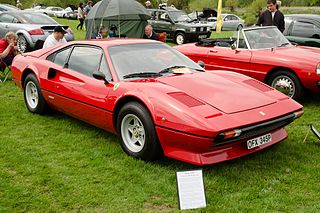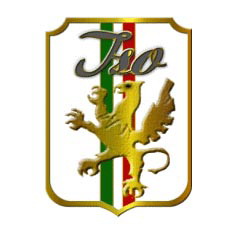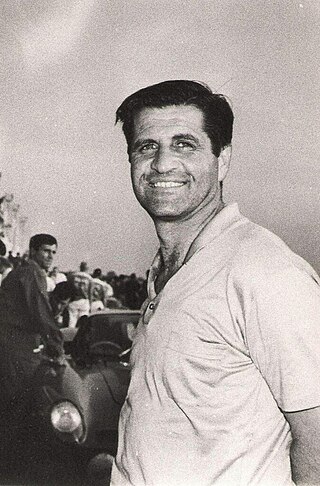
The Holden Monaro is a car which was manufactured by General Motors' Australian division Holden. It has a front-engine, rear-wheel-drive layout and was produced with a two-door coupé body from 1968 to 1975 and again from 2001 to 2006 and with a 4-door sedan body from 1973 to 1977.

ASA was an Italian automobile manufacturer active from 1961 to 1969, who is known for manufacturing the ASA 1000 GT. This car was developed by Ferrari engineers in the late 1950s as a less expensive, compact alternative to existing Ferrari GT cars. ASA used inline-four and straight-six engines derived from the "250" 3-litre V12 designed by Gioacchino Colombo. The chassis was developed by Giotto Bizzarrini and was derived from the tubular frame chassis of the 250 GTO.
ATS is an Italian automotive constructor. It once had a racing team that operated between 1963 and 1965, formed after the famous "Palace Revolution" at Ferrari.

The Ferrari 308 GTB berlinetta and targa topped 308 GTS are V8 mid-engined, two-seater sports cars manufactured by the Italian company Ferrari from 1975 until 1985. The 308 replaced the Dino 246 GT and GTS in 1975 and was updated as the 328 GTB/GTS in 1985. The similar 208 GTB and GTS were equipped with a smaller, initially naturally aspirated and later turbocharged, two-litre engine, and were sold mainly in Italy.

ISO Rivolta is an Italian car and motorbike manufacturer active in the motor vehicle sector since 1938. Over the years, the company has taken various names, including Isothermos, Iso Autoveicoli Spa in 1952, Iso Rivolta in 1962, Iso Motors in 1973 and, in 2017, a return to ISO Rivolta.

Bizzarrini S.p.A. was an Italian automotive manufacturer. In 1964, the company was founded by former Alfa Romeo, Ferrari and Iso engineer Giotto Bizzarrini. The company built a small number of highly developed and advanced sports and racing automobiles before failing in 1969. In 2020, it was announced that the name had been acquired by Pegasus brands, together with plans to restart production.

Giotto Bizzarrini was an Italian automobile engineer who was active from the 1950s through the 1970s.

The Bizzarrini Strada, is a sports car produced by Bizzarrini from 1964 to 1968. Sold as an exceptionally low slung, two-seat coupé, roadster, and track-tuned "Corsa" racer, it proved to be Bizzarrini's most successful model.
The Ferrari 330 was a series of V12 powered automobiles produced by Ferrari in 2+2 GT Coupé, two-seat Berlinetta, spyder, and race car versions between 1963 and 1968. The name "330" refers to the approximate displacement of each single cylinder in cubic centimeters.

The Ferrari 250 GT SWB Breadvan is a one-off Ferrari made in 1962 from a 1961 Ferrari 250 GT Berlinetta SWB, chassis number 2819 GT. It was built to compete against the new 1962 Ferrari 250 GTO at the 24 Hours of Le Mans and other FIA World Sportscar Championship races.

Gordon-Keeble was a British car marque, conceived in Slough, then constructed in Eastleigh, and finally in Southampton, between 1964 and 1967. The marque's badge was unusual in featuring a tortoise — a pet tortoise walked into the frame of an inaugural photo-shoot, taken in the grounds of the makers. Because of the irony the animal was chosen as the emblem.
The GM A platform was a rear wheel drive automobile platform designation used by General Motors from 1925 until 1959, and again from 1964 to 1981. In 1982, GM introduced a new front wheel drive A platform, and existing intermediate rear wheel drive products were redesignated as G-bodies.

The 1964 24 Hours of Le Mans was the 32nd Grand Prix of Endurance, and took place on 20 and 21 June 1964. It was also the ninth round of the 1964 World Sportscar Championship season.
Callaway Cars Inc. is an American specialty vehicle manufacturer and engineering company that designs, develops, and manufactures high-performance product packages for cars, pickup trucks, and SUVs. They specialize in Corvettes and GM vehicles. New GM vehicles are delivered to Callaway facilities where these special packages and components are installed. Then the vehicles are delivered to GM new car dealers where they are sold to retail customers, branded as Callaway. Callaway Cars is one of four core Callaway companies, including Callaway Engineering, Callaway Carbon and Callaway Competition.
The Vision Gran Turismo program is a series of concept cars for the Gran Turismo video game series, developed by a cross-section of the world's top automobile manufacturers. These cars appeared originally in the video game Gran Turismo 6, and later made an appearance in each subsequent Gran Turismo installment, all developed by Polyphony Digital. For the most part, they apply present-day technology and materials, with a handful of notable exceptions that utilize novel propulsion and aerodynamic technologies. Their appearance as free update content has been staggered since the launch of GT6 in 2013, with each one being available for download upon release.

The Iso Lele is a grand tourer that was produced by the Italian automobile manufacturer Iso Automoveicoli S.p.A. between 1969 and 1974. The Lele, being a 2+2-seater, filled the gap between the Grifo and the Fidia while sharing its powertrain with its siblings. The styling was done by Marcello Gandini of Bertone. The car is named after Lele Rivolta, wife of Piero Rivolta.

The Iso Rivolta is a grand tourer introduced in 1962 by Italian automobile manufacturer Iso Automotoveicoli S.p.A. Company chairman Renzo Rivolta and his colleague, former Ferrari engineer Giotto Bizzarrini, saw it as a gran turismo in the original sense of the term, designed for long and memorable journeys. It was the first luxury automobile introduced by the company which formerly specialised in affordable motor vehicles. For motor racing, an entirely different variant was made which bore a strong resemblance to the 1962 model Ferrari 250 GT SWB Breadvan and was homologated as a touring car.

Renzo Rivolta was an Italian Engineer.
Neri and Bonacini, also known as Nembo, was a small carrozzeria and mechanic shop based in Modena, Italy, active from the late 1950s to around 1967. Founded and run by Giorgio Neri and Luciano Bonacini, the shop worked on and produced bodies for Ferrari, Lamborghini and Maserati road and race cars, both in an official capacity for those manufacturers and for private owners. Their best known projects are the Ferrari 250 GT-based Nembo spiders and the Lamborghini 400GT Monza. Neri and Bonacini also designed a car under their own name, the Neri and Bonacini Studio GT Due Litri. Two prototypes of this car were made between 1966 and 1968 but it never entered series production. The shop closed around 1967 when Bonacini went to work for De Tomaso and Neri started his own shop, Motors-World-Machines (MWM).

Automobili Lamborghini S.p.A. is an Italian brand and manufacturer of luxury automobiles. Lamborghini's production facility and headquarters are located in Sant'Agata Bolognese, Italy. Italian manufacturing magnate Ferruccio Lamborghini founded the company in 1963 with the objective of producing a refined grand touring car to compete with offerings from established marques such as Ferrari. The company's first models were introduced in the mid-1960s and were noted for their refinement, power and comfort. Lamborghini gained wide acclaim in 1966 for the Miura sports coupé, which established rear mid-engine, rear wheel drive as the standard layout for high-performance cars of the era.



















